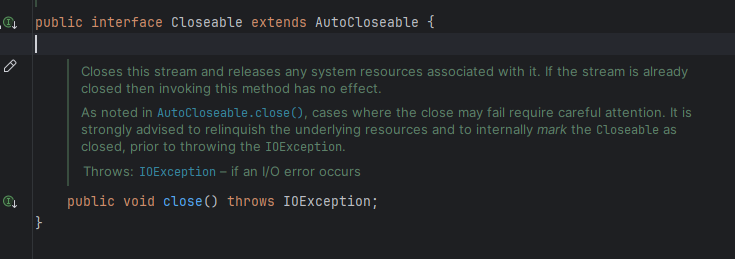
我们提供安全,免费的手游软件下载!
try-with-resources 是 JDK 7中引入的一种新的异常处理机制,它主要用于自动管理资源,能够很容易地关闭在 try-catch 语句块中使用的资源。确保资源在不再需要时能够被正确关闭。这种机制简化了资源管理,使得资源的释放更加安全和可预测。
resource :是指在程序完成后,必须关闭的对象(例如:文件资源File、IO流、Socket、ServerSocket网络对象、数据库链接对象等)。try-with-resources 语句确保了每个资源在语句结束时关闭。
class Myresources1 implements AutoCloseable {
@Override
public void close() throws Exception {
System.out.println("资源1关闭方法执行");
throw new Exception("资源1关闭异常");
}
}
class Myresources2 implements AutoCloseable {
@Override
public void close() throws Exception {
System.out.println("资源2关闭方法执行");
throw new Exception("资源2关闭异常");
}
}
为了避免在代码执行中出现异常,使用
try-catch-finally
进行异常捕获
Myresources1 myresources1 =null;
Myresources2 myresources2 = null;
try{
myresources1 = new Myresources1();
myresources2 = new Myresources2();
System.out.println("hello");
}catch (Exception e){
e.printStackTrace();
}finally {
if (myresources1!=null){
try {
myresources1.close();
}catch (Exception e){
e.printStackTrace();
}finally {
if (myresources2!=null){
try {
myresources2.close();
}catch (Exception e){
e.printStackTrace();
}
}
}
}
}

try(Myresources1 myresources1 = new Myresources1();
Myresources2 myresources2 = new Myresources2();){
System.out.println("hello");
//int a = 2/0;
}catch (Exception e){
e.printStackTrace();
}

 



Myresources1 myresources1 = null;
try{
myresources1 = new Myresources1();
//算数异常
System.out.println(10/0);
}finally {
if (myresources1!=null)
myresources1.close();
}
//myresources1类
class Myresources1 implements AutoCloseable {
@Override
public void close() throws Exception {
System.out.println("资源1关闭方法执行");
throw new Exception("资源1关闭异常");
}
}
运行异常打印:

此时可以看到,异常只打印了
close()
方法的异常,而 10/0 的异常被抑制了
try(Myresources1 myresources1 = new Myresources1();){
System.out.println(10/0);
}
运行异常打印:

addSuppressed()
方法把这些被抑制的方法记录下来,然后被抑制的异常就会出现在抛出的异常的堆栈信息中,可以通过
getSuppressed()
方法来获取这些异常。这样做的好处是不会丢失任何异常,方便我们进行调试。

Myresources1 myresources1 = new Myresources1();
Throwable var2 = null;
try {
System.out.println(10 / 0);
} catch (Throwable var11) {
var2 = var11;
throw var11;
} finally {
if (myresources1 != null) {
//判断程序运行时是否出现异常
if (var2 != null) { //出现异常
try {
myresources1.close();
} catch (Throwable var10) {
var2.addSuppressed(var10); //把close()发生的异常添加为抑制异常
}
} else { //程序运行时无异常
myresources1.close();
}
}
}
循环打印抑制异常
try(Myresources1 myresources1 = new Myresources1();){
System.out.println(10/0);
}catch (Exception e){
e.printStackTrace();
Throwable[] suppressed = e.getSuppressed();
for (Throwable t : suppressed){
t.printStackTrace();
}
}
运行结果:

try-with-resources
语法适用于任何需要自动管理资源关闭,以防止资源泄漏的场景。
简单粗暴点就是,ctrl点进去看当前资源,只要当前资源实现了AutoCloseable或者Closeable接口就可以用。但是,具体使用还要根据要实现的业务场景来决定。
如果资源没有实现
AutoCloseable
或
Closeable
接口,那么它就不能在
try-with-resources
语句中被自动关闭。这种情况下,仍然需要手动关闭资源,或者使用其他机制来确保资源的正确关闭。
try-with-resources
语句中的资源在 try块执行完毕后会自动关闭,因此在 try块外部无法访问这些资源。如果资源需要在
try
块外部被使用,那么就不能使用
try-with-resources
语句来管理这些资源。
在某些情况下,开发者可能需要根据特定的逻辑或条件来决定何时关闭资源,而不是在
try
块结束时立即关闭。
try-with-resources
语句无法提供这种精细的控制,因此在这些场景下可能不适用。
虽然
try-with-resources
语句会尝试关闭资源,并捕获在关闭过程中抛出的异常,但这些异常通常会被抑制(suppressed),而不是直接抛出。如果开发者需要特别处理这些关闭异常,或者需要将这些异常与
try
块中抛出的其他异常进行区分,那么
try-with-resources
可能不是最佳选择。
如果一个资源需要在多个
try
块中被共享和使用,那么使用
try-with-resources
语句可能会变得复杂或不可行。因为每个
try-with-resources
语句都会尝试在结束时关闭其声明的资源,这可能会导致资源在需要时已经被关闭。
如果资源的关闭逻辑非常复杂,或者需要在关闭前执行一些特定的操作(如回滚事务、释放锁等),那么使用
try-with-resources
语句可能不足以满足需求。在这些情况下可能需要编写更复杂的
finally
块来确保资源的正确关闭。综上所述,
try-with-resources
语句虽然是一种强大的资源管理机制,但它并不适用于所有场景。在选择是否使用
try-with-resources
时,开发者需要根据具体的需求和资源的特点来做出决策。
finally
块中编写资源关闭的代码,减少了代码量和出错的可能性。
try
块中发生异常,资源也会被自动关闭,避免了资源泄漏的风险。
支持的资源类型有限:并非所有的类都可以作为
try-with-resources
的资源,只有实现了
AutoCloseable
或
Closeable
接口的类才行。
性能考虑:
虽然
try-with-resources
在大多数情况下对性能的影响可以忽略不计,但在极端情况下(例如:在性能敏感的应用程序中频繁地打开和关闭大量资源),它可能会引入一些额外的开销。这是因为
try-with-resources
语句在编译时会生成额外的代码来管理资源的关闭。
对在
try()
中声明的对象不能重新赋值
FileWriter fw = new FileWriter("a.txt");
fw = new FileWriter("e:/b.txt");
try(FileWriter fw = new FileWriter("a.txt")){
fw = new FileWriter("b.txt"); //报错
}catch (Exception e){
e.printStackTrace();
}
//此时会编译出错:The resource is1 of a try-with-resources statement cannot be assigned
官方文档:
It is a compile-time error if final appears more than once as a modifier for each variable declared in a resource specification.
A variable declared in a resource specification is implicitly declared final (§4.12.4) if it is not explicitly declared final.
在资源规范中声明的每个变量,如果 final 作为修饰符出现不止一次,则属于编译时错误。
在资源规范中声明的变量,如果没有显式地声明为 final,则隐式地声明为 final(§4.12.4)。
try-with-resource中声明的变量会隐式的加上final 关键字,所以无法再进行赋值
try-with-resources
的优点通常大于缺点,在大多数情况下,它是一种更安全、简洁和可靠的资源管理方式。具体的使用方式根据业务场景决定,但是一般情况下,处理必须关闭的资源时,始终有限考虑使用 try-with-resources,而不是 try–catch-finally。前者产生的代码更加简洁、清晰,产生的异常信息也更靠谱。
热门资讯